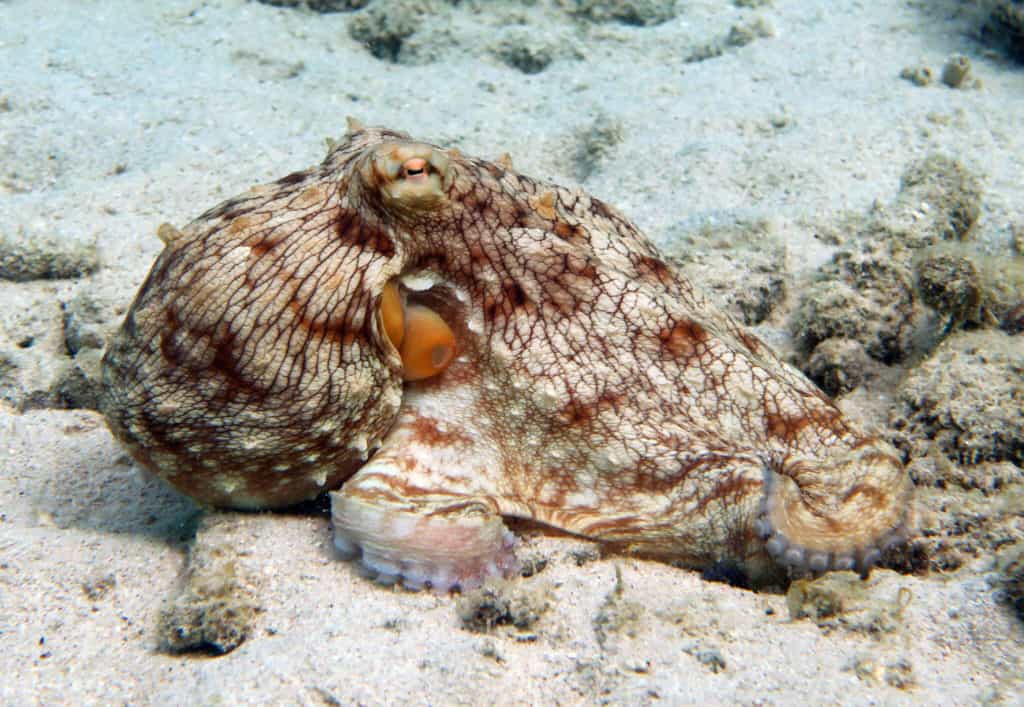The Octopus is a super-intelligent creature that keeps on surprising us as we learn more and more about them.
These creatures are escape artists that are capable of problem-solving, planning, learning, and a lot more!
In this post, we’re going to take a closer look at the Octopus’s blood, and answer a question many of our readers ask. Do Octopuses have blue blood?
Yes, Octopuses do have blue blood. The reason for this is that, unlike the Iron that we have in our own hemoglobin, which is a protein. Octopuses have a protein called hemocyanin which contains copper, making their blood blue.
Do Octopuses Really Have Blue Blood?
It can seem a little strange to find out that Octopuses have blue blood, but they are not the only creature that does.
Spiders, Snails, and Squid all have blue blood, with some animals having green or even purple blood.
One of the purposes of blood is to transport oxygen around the body to supply tissues and play a key role in the Octopuses’ survival.
Regardless of whether the blood is blue, red, purple, or green it all plays the same role throughout organisms to transport oxygen and keep animals alive.
Why Is Octopus Blood Blue?
So why is Octopus blood blue? Well, the blue blood is because of a protein known as hemocyanin, which carries oxygen around the Octopuses body.
Hemocyanin relies on copper, rather than Iron as the binding mineral of choice. When copper binds to oxygen, the discoloration is different which results in the blue color of their blood.
Human red blood contains Iron, which is why it is such an important part of our diets. The Iron in our blood is contained within hemoglobin, which enables oxygen to be transported to our organs and tissues.
Iron binds to oxygen, which is why the color of our blood is red. When Iron is oxidized in nature, we also see a similar color, which is the color of rust.
Hemoglobin is an incredibly effective way for our blood to transport oxygen as opposed to some of the other methods we see in nature.
One interesting part is that hemocyanin plays a key part in the adaption of squids and octopuses to their environment.
Many Octopuses live near the seafloor, often in extreme or arctic conditions, in some cases up to – 30 degrees Fahrenheit.
In temperatures such as this, oxygen binds more tightly to proteins and if this oxygen can’t be separated and delivered to organ systems, it can cause the Octopus to suffocate.
Thankfully, these animals are incredibly well adapted to life in the ocean, and they are able to regulate the amount of hemocyanin concentration in their blood by as much as 40% depending on the species.
Octopuses also have three hearts and need much more oxygen than other invertebrates, so the hemocyanin allows Octopuses to get a steady oxygen supply even when it isn’t readily available in their environment.
This allows Octopuses to survive in extreme environments with low temperatures.
Researchers even suspect that the blue blood of Octopuses is the result of their inability to migrate long distances away from their challenging living conditions.
They have relatively short life spans due to their lifestyle and they move by crawling along the seafloor, which makes migrating simply out of the question.
Octopuses simply had to evolve over many years to survive in their chosen habitats, which they did.
Hemocyanin makes much more sense for Octopuses when looking at their anatomy and extreme living conditions.
Final Thoughts
So do Octopuses have blue blood? Yes, they certainly do. In fact, they may be the original species that has blue blood.
Their blue is blood because it contains hemocyanin, which is a protein that contains copper. This allows Octopuses to pump oxygen around their bodies whilst living in extreme conditions.
Hopefully, you’ve learned something new today about why Octopuses have blue blood.
Thanks for taking the time to read this post and feel free to stick around to learn more about Octopuses and other marine life.

Hi, I’m George – the founder of MarinePatch. I created this blog as marine wildlife has been my passion for many years. I’ve spent over a decade in the marine wildlife industry and spent years out in the field conducting research. In today’s modern world, an online blog is the best place for me to share my findings and reach as many people as possible to help educate and inspire others. Enjoy your time here and you’re welcome back anytime!

